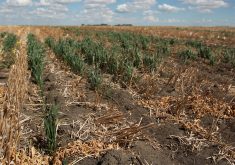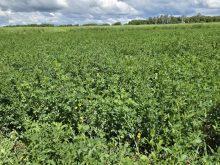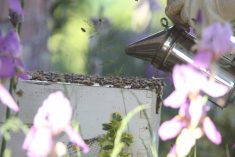November brought little relief for producers living through dry conditions across Alberta.
Precipitation remains rare and many mountain snowpack stations are reporting below average levels, as 51 water shortage advisories stretch across the province, north to south.
Seasonal forecasts predict little reprieve in the next three months as an El Nino weather system moves in.
Mother Nature teased Albertans with near normal precipitation levels in October but dry conditions returned in November, except for areas west of Edmonton and parts of Peace Country.
Provincial government ministries and the Alberta Energy Regulator are co-ordinating preparations in case the province faces similar or worse conditions as 2023 going into next year.
Read Also

Bunge’s crop mix is changing
Bunge has predominantly been a soybean processing firm, but that’s about to change after the merger with Viterra with softseed processing and grain merchandising gaining ground.
“Global weather forecasts project above-average temperatures and below-normal precipitation this winter,” reads a statement on the situation on Alberta government’s drought information website. “If there is insufficient or concerning snowpack, we will work with partners in the agriculture industry to determine what additional steps are needed to help manage and conserve water in 2024.”
Brooks, Alta.-based weather specialist Brandon Houck said the winter outlook isn’t looking good for precipitation relief in the heart of the province’s irrigation country and El Nino is the primary factor.
“We’ve had El Nino hitting us hard this year with severe drought conditions across southern Alberta,” he said.
The weather pattern has warmed up waters in the Pacific Ocean, which has led to those impacts being felt on the Prairies, said Houck.
“We’ve had above-normal temperatures through the month of November as well and I do believe this El Nino pattern is going to persist well into the winter season and with signals of possibly above-average temperatures and below-average precipitation. That’s usually the case with El Nino-type patterns,” said Houck.
Two scenarios are likely, he added. The rest of the winter is expected to be similar to November, with above-average temperatures, a teasing of snow and some cold snaps. The other possibility is an average winter with normal precipitation and temperatures.
But Houck said winter seasonal forecasts are difficult to accurately predict.
“All you need is a plume of Arctic air working with Pacific air and you get those two air masses working together, we could be in for a bit of a ride in a snowstorm, blizzard scenario at some point this winter,” said Houck. “Or, we could see the (jet stream) ridge continue to dominate.”
The latter situation will keep precipitation levels low in the southern Prairies and keep moisture in the northern parts of the western provinces.
As for the best-case scenario, Houck said that would require more Arctic air to move in and push the jet stream across the southern Prairies, allowing the region to get onto the storm track.
While still below normal, reservoir levels have recovered in Eastern and Bow River irrigation districts but that’s not the case for the systems that run off the St. Mary and Oldman rivers.
The Oldman Dam reservoir continues to see levels drop and may reach 25 percent capacity by early December, if current patterns continue. The situation is similar to 2001 conditions that saw a quick recovery to levels at the Oldman Dam reservoir because of favourable conditions in the spring of 2002.
Lethbridge Northern Irrigation District’s headworks at the reservoir, which has delayed the start of the 2022 and 2023 seasons because of a dispute with the Piikani Nation and issues with repairs respectively is anticipated to see those problems rectified by the spring of 2024.
















